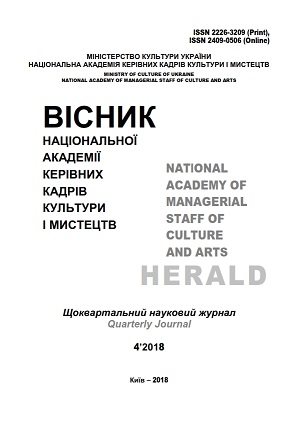The Role of the Radzivil Family in the Formation of the Historical, Cultural and Artistic Panorama of Europe in the XVIII–XIX Centuries
The Role of the Radzivil Family in the Formation of the Historical, Cultural and Artistic Panorama of Europe in the XVIII–XIX Centuries
Author(s): Olha Voldimirivna ShkolnaSubject(s): Cultural history, Social history, Social development, 18th Century, 19th Century, History of Art
Published by: Національна академія керівних кадрів культури і мистецтв
Keywords: Radzivils; the Eastern Europe; manufactures of faience; glass; semi-precious stones; textiles; furniture of ХVІІІ–ХІХ centuries;
Summary/Abstract: The purpose of the work is to systematize the information concerning the industrial productions founded by representatives of the Radzivil family in Europe. The research methodology is based on application of historical-cultural and art criticism approaches and historical-chronological method, which allows to realize specificity of occurrence and development during baroque-romanticism epoch in the ethnic territories of Ukraine, Belarus and Poland of some manufactories. Taken together these specified approaches and methods allow to open the importance of the outlined problematics from the point of view of practical cultural science and art criticism through a prism of historical and cultural and art aspects. Scientific novelty consists in definition of specificity of the organization of the old-world industrial productions of faience, art glass, jewels, textiles and furniture by the representatives of Radzivil family. It is proved, that a number of manufactures of the designated sort in Zhovkva, Glinsko, Byala Podlyaska, Swerzhen, Neborov, Uritshya, Naliboki, Tshudnov, Olyka, Mir, Alba, Nesvizh, Korelytchi, Slutsk, Lakhwa, based by the Radzivils, laid the foundation of development of a network of the industrial enterprises of capitalist time in the territories of Eastern Europe. Conclusions. Nowadays it is possible in retrospection to look at the principles of foundation and specificity of infrastructure of the first industrially and financially successful enterprises in the ethnic territories of Ukraine, Belarus, Poland and Lithuania. The designated territories once were a part of the Grand Duchy of Lithuania and Polish-Lithuanian Commonwealth, economically developed European states. From the end of ХVІІ – beginning ХVІІІ century Radzivils here confirmed by the means of comprehension of separate segments of industrial production their ability to be leaders among domestic industrial centers.
Journal: Вісник Національної академії керівних кадрів культури і мистецтв
- Issue Year: 2018
- Issue No: 4
- Page Range: 226-231
- Page Count: 6
- Language: English

